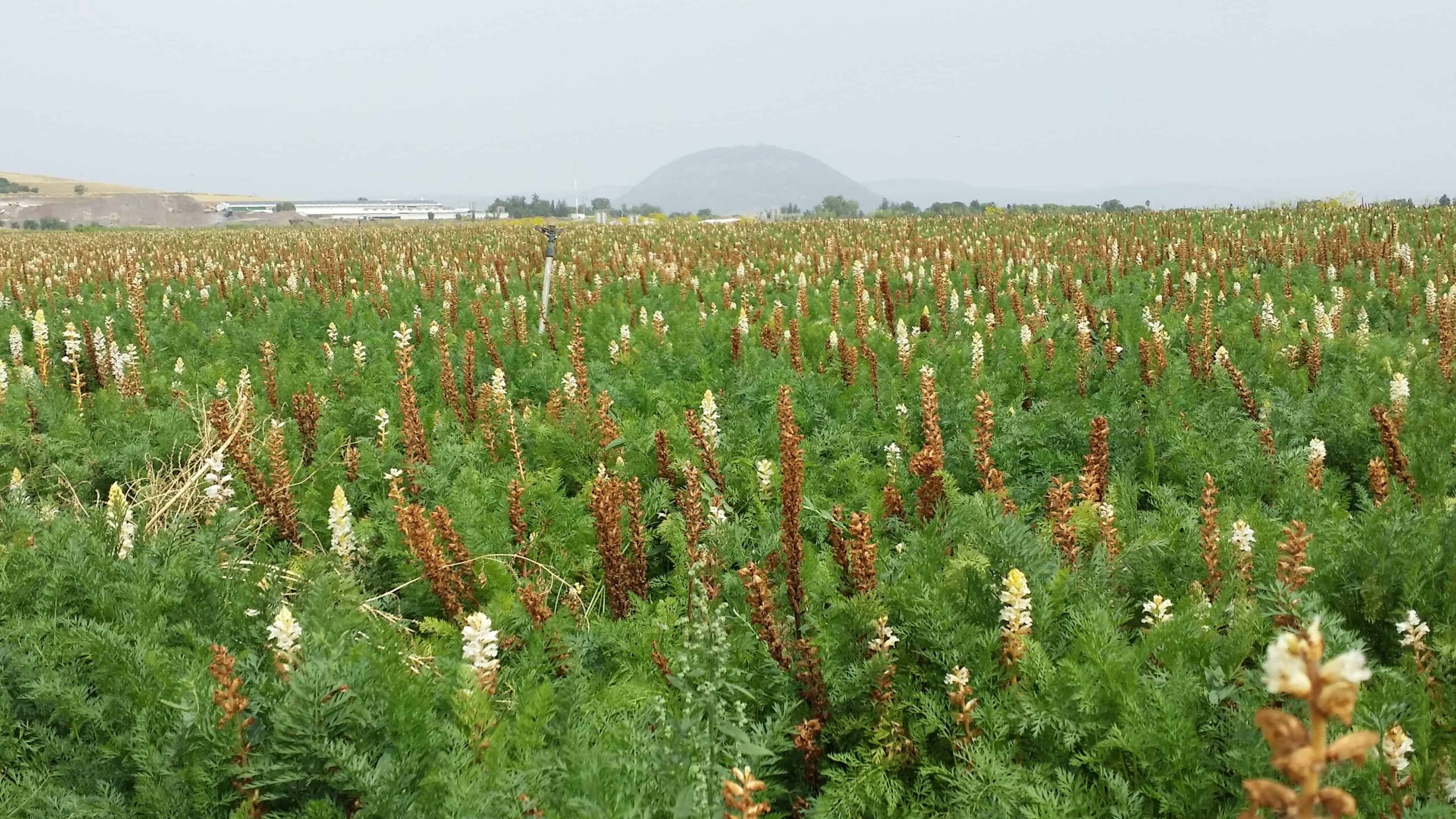| Title | Excerpt | Date Posted |
|---|---|---|
| Complete chloroplast genomes of five Cuscuta species and their evolutionary significance in the Cuscuta genus |
Background Cuscuta, a parasitic plant species in the Convolvulaceae family, grows in many countries and regions. However, the relationship between some species is still unclear. Therefore, more studies are needed to assess the variation of the chloroplast (cp) genome in Cuscuta species and their relationship with subgenera or sections, thus, providing important information on the […] |
July 20, 2023 |
| Resource availability and parasitism intensity influence the response of soybean to the parasitic plant Cuscuta australis |
Introduction: Parasitic plants can damage crop plants and consequently cause yield losses and thus threaten food security. Resource availability (e.g., phosphorus, water) has an important role in the response of crop plants to biotic attacks. However, how the growth of crop plants under parasitism are affected by environmental resource fluctuation is poorly understood. Methods: We […] |
May 20, 2023 |
| Transcriptome analysis reveals defense-related genes and pathways during dodder (Cuscuta australis) parasitism on white clover (Trifolium repens) |
Dodders (Cuscuta australis R. Br.) are holo-parasitic stem angiosperms with an extensive host range that have significant ecological and economic potential impact on the ecosystem and the agricultural system. However, how the host plant responds to this biotic stress remains mostly unexplored. To identify the defense-related genes and the pathways in white clover (Trifolium repens […] |
March 20, 2023 |
| Dodder parasitism limited the effect of arbuscular mycorrhizal fungi on litter decomposition |
Effects from parasitism and parasitic litter input can affect the decomposition of litter, but the mechanism is unclear. We hypothesized that the decomposition of litter produced by the holoparasite Cuscuta australis is promoted more strongly by arbuscular mycorrhizal fungi (AMF) than the litter of its host Bidens pilosa and that parasitism by C. australis can […] |
January 20, 2023 |
| Parasitism Shifts the Effects of Native Soil Microbes on the Growth of the Invasive Plant Alternanthera philoxeroides |
Soil microbes play an important role in plant invasion, and parasitic plants regulate the growth of invasive plants. However, the mechanisms by which parasitic plants regulate the effects of soil microbes on invasive plants have not been investigated. Here, we used the invasive plant Alternanthera philoxeroides and the holoparasitic plant Cuscuta grovonii to test whether […] |
|
| Effects of Parasitism on the Competitive Ability of Invasive and Native Species |
Parasitic plants can often seriously harm host plants and, thus, alter competitive dominance between hosts and neighbouring species. However, whether and how parasitic plants differently affect the competitive abilities of invasive and the native plants have not been tested. In this study, we used Cuscuta grovonii as the parasitic plants and three invasive plants and […] |
November 20, 2022 |
| Parasitic plants indirectly regulate decomposition of soil organic matter |
1. Parasitic plants have been shown to affect soil-organic-matter (SOM) decomposition, but the mechanism is unknown. As arbuscular mycorrhizal fungi (AMF) can affect decomposition and compete with parasitic plants for carbon, we hypothesized that parasitic plants can indirectly regulate SOM decomposition by suppressing the effects of AMF on decomposition. 2. To test this hypothesis, we […] |
|
| Cuscuta australis Parasitism-Induced Changes in the Proteome and Photosynthetic Parameters of Arabidopsis thaliana |
Cuscuta australis is a widely distributed stem parasitic plant, infecting a variety of host plants. Its parasitism has a negative effect on the hosts, mainly due to the exhaustion of nutrients, thus negatively affecting the growth and development. However, recent studies indicated that the effect of parasitism may extend beyond the simple extraction of organic […] |
October 20, 2022 |
| Implications of climate change for environmental niche overlap between five Cuscuta pest species and their two main Leguminosae host crop species |
Some parasitic plants are major pests in agriculture, but how this might be affected by climate change remains largely unknown. In this study, we assessed this question for five generalist holoparasitic Cuscuta species (smoothseed alfalfa dodder [Cuscuta approximata Bab.], alfalfa dodder [Cuscuta europaea L.], soybean dodder [Cuscuta chinensis C. Wright], Peruvian dodder [Cuscuta australis R. […] |
August 20, 2022 |
| Molecular Processes of Dodder Haustorium Formation on Host Plant under Low Red/Far Red (R/FR) Irradiation |
Low R/FR irradiation can promote dodder haustorium formation on the host plant; however, the mechanisms underlying the process are still unknown. In this study, we compared the transcriptomic data during the formation of haustorium of Cuscuta chinensis on host plant Arabidopsis thaliana under low (R/FR = 0.1) versus high (R/FR = 0.2) R/FR irradiation at […] |
July 20, 2022 |
| Integrated small RNA, mRNA, and degradome sequencing reveals the important role of miRNAs in the interactions between parasitic plant Cuscuta australis and its host Trifolium repens |
Cuscuta australis R.Br. is a stem parasite that obtains water and nutrients from host plants, with which it also exchanges proteins and mRNAs with host plants. Recently, a study found that novel miRNAs accumulated during C. campestris Yunk. parasitism of Arabidopsis thaliana L. However, the fate of miRNAs transferred from parasite to host plants as well as their […] |
December 2, 2021 |
| A parasite indirectly affects nutrient distribution by common mycorrhizal networks between host and neighboring plants |
Cascading effects are ubiquitous in nature and can modify ecological processes. Most plants have mutualistic associations with mycorrhizal fungi, and can be connected to neighboring plants through common mycorrhizal networks (CMNs). However, little is known about how the distribution of nutrients by CMNs to the interconnected plants is affected by higher trophic levels, such as […] |
November 30, 2021 |
© Copyright IPPS 2010-2024 • Disclaimer • Privacy • Terms and conditions • Contact
